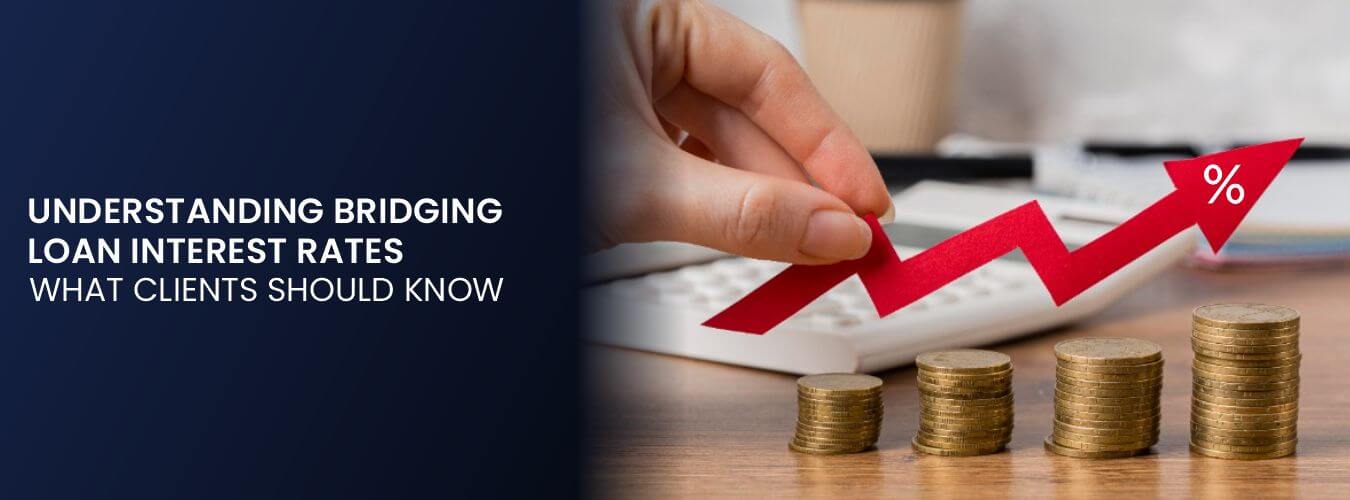MENU
MENU

When purchasing or refinancing commercial property, timing can make or break a deal. Traditional lenders are often slow, which is why many investors and businesses turn to bridging loans. These short-term finance solutions can unlock opportunities quickly, but one question always comes up: what about the interest rates? In this guide, we’ll break down bridging loan interest in plain language. You’ll learn how rates are set, why they vary, and how they influence the total cost of short-term funding.
We’ll explore examples drawn from commercial property financing, highlight what clients often overlook, and end with practical advice to make informed borrowing decisions.
Bridging loans are designed as a temporary financing bridge between the purchase of a property and a longer-term funding option, such as a mortgage or property sale. Unlike traditional mortgages, which have interest calculated annually, bridging loan interest is typically charged on a monthly basis. For commercial property transactions, typical bridging loan interest rates start at 1.5% per month.
At first glance, this might seem low. However, because interest accumulates monthly, the annualized cost can appear higher than long-term funding. For example, if you borrowed £500,000 against a commercial property for 6 months at 1.5% per month, your interest charges alone would amount to approximately £45,000 (ignoring fees). That is why clients should carefully assess how bridging finance fits within their broader investment or business strategy.
No two clients pay the same bridging loan interest rate. Lenders consider multiple variables, and understanding them can help you present a stronger case. Here are the most important factors:
By understanding these elements, clients can recognise what’s in their control and what is not.
Interest charges on bridging loans can be structured in different ways. This is often misunderstood and can change the affordability picture significantly. Let’s look at the three main methods:
Choosing the right interest payment structure depends on your cash flow needs and the timeline of your exit strategy.
Imagine a company acquiring a commercial property to repurpose it into offices. They need fast financing because a competitor is also interested in the same building. The purchase price is £800,000, and they require a loan of £600,000, which is 75% LTV.
If rolled-up interest is chosen, the monthly charge (£9,000) is added to the balance each month. By the end of 9 months, the interest equals £81,000, which is then repaid along with the principal and fees. For the company, this is acceptable because they plan to refinance into a longer-term commercial mortgage, and the uplifted property value will cover these costs. Practical insight: this calculation shows why bridging loans are powerful tools for short-term opportunities, but not intended for holding property long-term.
Clients often make the mistake of looking only at bridging loan interest rates while ignoring other costs involved. To make a fully informed decision, account for:
When these costs are added to the monthly bridging loan interest, the overall expense can alter the real value of the funding.
Over the years, we’ve seen clients make repeated mistakes when it comes to navigating bridging finance. Here are some insights that can save considerable stress and expense:
Bridging loans for commercial property are flexible in terms of eligibility. Applicants include:
With loans ranging from £100,000 to £1,000,000, commercial bridging loans are available to a wide range of borrowers, including small businesses and seasoned investors. Flexibility around freehold and leasehold tenure also makes this product attractive in different scenarios.
Commercial bridging loans remain popular because businesses and investors rarely have the luxury of time. Common uses include:
In every case, the common denominator is speed. Bridging allows clients to move forward without waiting months for conventional funding approval.
Understanding bridging loan interest rates is crucial before entering into any agreement. On the surface, rates starting from 1.5% per month may feel attractive, but when compounded over several months along with arrangement fees, the cost becomes more substantial.
That said, for clients seeking fast-moving commercial opportunities, bridging finance is often the difference between securing the property and missing it altogether. The key is balancing speed with cost-effectiveness, while always keeping the repayment exit in sight.
If you’re considering bridging finance for a commercial property, now is the right time to speak with a professional bridging finance provider. A single conversation can help you compare lenders, assess the true cost of borrowing, and structure a deal that protects your business ambitions.